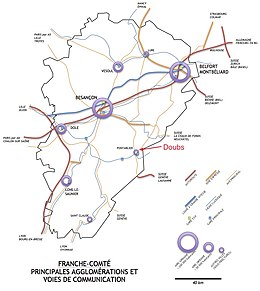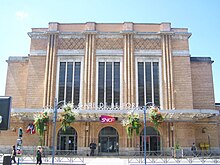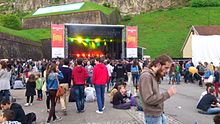Prefecture and commune in Bourgogne-Franche-Comté, France
| Belfort | |
|---|---|
| Prefecture and commune | |
 An aerial view of Belfort with the Cathedral of Saint-Christophe in the foreground An aerial view of Belfort with the Cathedral of Saint-Christophe in the foreground | |
 Coat of arms Coat of arms | |
| Location of Belfort | |
  | |
| Coordinates: 47°38′N 6°51′E / 47.64°N 6.85°E / 47.64; 6.85 | |
| Country | France |
| Region | Bourgogne-Franche-Comté |
| Department | Territoire de Belfort |
| Arrondissement | Belfort |
| Canton | 3 cantons |
| Intercommunality | CA Grand Belfort |
| Government | |
| • Mayor (2020–2026) | Damien Meslot |
| Area | 17.10 km (6.60 sq mi) |
| • Urban | 106.8 km (41.2 sq mi) |
| • Metro | 633.2 km (244.5 sq mi) |
| Population | 45,646 |
| • Density | 2,700/km (6,900/sq mi) |
| • Urban | 79,364 |
| • Urban density | 740/km (1,900/sq mi) |
| • Metro | 133,597 |
| • Metro density | 210/km (550/sq mi) |
| Time zone | UTC+01:00 (CET) |
| • Summer (DST) | UTC+02:00 (CEST) |
| INSEE/Postal code | 90010 /90000 |
| Dialling codes | 0384 |
| Elevation | 354–650 m (1,161–2,133 ft) (avg. 358 m or 1,175 ft) |
| French Land Register data, which excludes lakes, ponds, glaciers > 1 km (0.386 sq mi or 247 acres) and river estuaries. | |
Belfort (French pronunciation: [bɛlfɔʁ] ; archaic German: Beffert, Beffort) is a city in northeastern France, situated approximately 25 km (16 mi) from the Swiss border. It is the prefecture of the Territoire de Belfort.
Belfort is 400 km (250 mi) from Paris and 55 km (34 mi) from Basel. The residents of the city are called "Belfortains". The city is located on the river Savoureuse, on a strategically important natural route between the Rhine and the Rhône – the Belfort Gap (Trouée de Belfort) or Burgundian Gate (Porte de Bourgogne). It is located approximately 16 km (10 mi) south from the base of the Ballon d'Alsace mountain range, source of the Savoureuse. The city of Belfort has 46,443 inhabitants (2019). Belfort is the centre of a larger functional area (metropolitan area) with 133,597 inhabitants (2018), between the larger metropolitan areas of Mulhouse and Montbéliard.
History


Early history
Belfort's strategic location, in a natural gap between the Vosges and the Jura, on a route linking the Rhine and the Rhône, has attracted human settlement since Roman times, and has also made it a frequent target for invading armies many times in its history.
The site of Belfort was inhabited in Gallo-Roman times. Later, it was heavily settled by Germanic peoples during the Germanic migrations, most notably the Burgundians, who settled in the region after the Gallo-Roman inhabitants had been displaced. It was subsequently recorded in the 13th century as a possession of the counts of Montbéliard, who granted it a charter in 1307.
Previously an Austrian possession, Belfort was transferred to France by the Treaty of Westphalia (1648), which ended the Thirty Years' War. The town's fortifications were extended and developed by the military architect Vauban for Louis XIV. The Hôtel de Ville was completed in 1724.
Franco-Prussian War
Until 1871, Belfort was part of the département of Haut-Rhin, in Alsace. The Siege of Belfort (between 3 November 1870 and 18 February 1871) during the Franco Prussian war was successfully resisted by the French until the garrison was ordered to surrender 21 days after the armistice between France and Prussia ended the war. The region was not annexed by Prussia like the rest of Alsace was. It was exchanged for territories in the vicinity of Metz. It formed, as it still does, the Territoire de Belfort. The siege is commemorated by a huge statue, the Lion of Belfort, by Frédéric Bartholdi. Alsatians not wanting to live under German rule in annexed Alsace and who wanted a French life and home in Belfort made a significant contribution to Belfort and French industry (see Société Alsacienne de Constructions Mécaniques) after 1872.
1892 Paris-Belfort running race
On 5 June 1892, Le Petit Journal organised a foot-race from Paris to Belfort, a course of over 380 km (240 mi), the first large-scale long-distance running race on record. Over 1,100 competitors registered for the event and over 800 started from the offices of Le Petit Journal, at Paris Opera. This had also been the start point for the inaugural Paris–Brest–Paris cycle-race the previous year. The newspaper's circulation dramatically increased as the French public followed the progress of race participants, 380 of whom completed the course in under ten days. In Le Petit Journal on 18 June 1892, Pierre Giffard praised the event as a model for the physical training of a nation faced by hostile neighbours. The event was won by Constant Ramoge in 100 hours, 5 minutes.

World War One
The town was bombarded by the German Army during World War I. Before the war, the September Programme of German Imperial Chancellor Theobald von Bethmann Hollweg, pressed for expansionist aims of French territory, specifically advocated the annexation of the Belfort region along with the western side of the Vosges Mountains.
World War Two
After the 1940 Battle of France with the German victory, Belfort fell within the Nazi German occupation zone. In November 1944, the retreating Wehrmacht held off the French First Army outside the town until French Commandos made a successful night attack on the Salbert Fort. Belfort was liberated on 22 November 1944. It is believed that Adolf Hitler intended to annex Belfort into the German Gau Baden–Alsace, but it never took place.
Geography
Climate
Belfort has an oceanic climate (Köppen climate classification Cfb). The average annual temperature in Belfort is 10.1 °C (50.2 °F). The average annual rainfall is 1,122.3 mm (44.19 in) with December as the wettest month. The temperatures are highest on average in July, at around 19.2 °C (66.6 °F), and lowest in January, at around 1.2 °C (34.2 °F). The highest temperature ever recorded in Belfort was 38.0 °C (100.4 °F) on 13 July 1949; the coldest temperature ever recorded was −21.4 °C (−6.5 °F) on 10 February 1956.
| Town | Sunshine (hours/yr) |
Rain (mm/yr) |
Snow (days/yr) |
Storm (days/yr) |
Fog (days/yr) |
|---|---|---|---|---|---|
| National average | 1,973 | 770 | 14 | 22 | 40 |
| Belfort | N/A | 1,121.2 | 30.6 | 25.9 | 41.8 |
| Paris | 1,661 | 637 | 12 | 18 | 10 |
| Nice | 2,724 | 767 | 1 | 29 | 1 |
| Strasbourg | 1,693 | 665 | 29 | 29 | 56 |
| Brest | 1,605 | 1,211 | 7 | 12 | 75 |
| Climate data for Belfort (1981–2010 averages, extremes 1946−2013) | |||||||||||||
|---|---|---|---|---|---|---|---|---|---|---|---|---|---|
| Month | Jan | Feb | Mar | Apr | May | Jun | Jul | Aug | Sep | Oct | Nov | Dec | Year |
| Record high °C (°F) | 16.9 (62.4) |
20.4 (68.7) |
25.2 (77.4) |
29.0 (84.2) |
32.1 (89.8) |
35.0 (95.0) |
38.0 (100.4) |
37.5 (99.5) |
34.0 (93.2) |
27.5 (81.5) |
20.3 (68.5) |
18.2 (64.8) |
38.0 (100.4) |
| Mean daily maximum °C (°F) | 3.8 (38.8) |
5.7 (42.3) |
10.3 (50.5) |
14.3 (57.7) |
18.8 (65.8) |
22.1 (71.8) |
24.5 (76.1) |
24.2 (75.6) |
19.6 (67.3) |
14.6 (58.3) |
8.1 (46.6) |
4.5 (40.1) |
14.3 (57.7) |
| Daily mean °C (°F) | 1.2 (34.2) |
2.3 (36.1) |
6.1 (43.0) |
9.4 (48.9) |
13.8 (56.8) |
16.9 (62.4) |
19.2 (66.6) |
18.9 (66.0) |
15.0 (59.0) |
10.7 (51.3) |
5.2 (41.4) |
2.1 (35.8) |
10.1 (50.2) |
| Mean daily minimum °C (°F) | −1.5 (29.3) |
−1.1 (30.0) |
1.9 (35.4) |
4.6 (40.3) |
8.7 (47.7) |
11.7 (53.1) |
13.8 (56.8) |
13.6 (56.5) |
10.3 (50.5) |
6.9 (44.4) |
2.3 (36.1) |
−0.4 (31.3) |
5.9 (42.6) |
| Record low °C (°F) | −20.6 (−5.1) |
−21.4 (−6.5) |
−14.1 (6.6) |
−6.1 (21.0) |
−3.7 (25.3) |
1.7 (35.1) |
4.6 (40.3) |
4.4 (39.9) |
0.3 (32.5) |
−6.0 (21.2) |
−10.1 (13.8) |
−16.7 (1.9) |
−21.4 (−6.5) |
| Average precipitation mm (inches) | 97.6 (3.84) |
86.6 (3.41) |
88.7 (3.49) |
71.8 (2.83) |
100.9 (3.97) |
85.7 (3.37) |
81.4 (3.20) |
88.1 (3.47) |
96.0 (3.78) |
106.0 (4.17) |
99.4 (3.91) |
120.1 (4.73) |
1,122.3 (44.19) |
| Average precipitation days (≥ 1.0 mm) | 12.3 | 11.1 | 12.3 | 10.8 | 13.0 | 11.0 | 10.4 | 10.6 | 9.8 | 11.9 | 12.2 | 13.4 | 138.9 |
| Source: Météo France | |||||||||||||
Population
|
| ||||||||||||||||||||||||||||||||||||||||||||||||||||||||||||||||||||||||||||||||||||||||||||||||||||||||||||||||||
| |||||||||||||||||||||||||||||||||||||||||||||||||||||||||||||||||||||||||||||||||||||||||||||||||||||||||||||||||||
| Source: EHESS and INSEE (1968-2017) | |||||||||||||||||||||||||||||||||||||||||||||||||||||||||||||||||||||||||||||||||||||||||||||||||||||||||||||||||||
Economy
Belfort is a centre for heavy engineering industries, mostly dedicated to railways and turbines. Belfort is the hometown of Alstom where the first TGVs (Trains à Grande Vitesse, High Speed Trains) were produced, as well as hosting the GE Power European headquarters and a centre of excellence for the manufacturing of gas turbines.
Transport


Road
Belfort is located at a busy hub in the region's local and long-distance road network. Its proximity to the commercial port of Mulhouse-Rhin facilitates international trade. The motorway A36 from Beaune to Mulhouse follows a route to the south and east of the city, and forms the main axis linking Belfort to other French and European cities. Passing just south of town, N19 connects Langres (and thereby Paris and Troyes) to the Swiss canton of Jura.
Air
EuroAirport Basel-Mulhouse-Freiburg is located about 60 km (37 mi) east of Belfort (1 hour drive).
Rail links

Belfort is well connected with the rest of France, with direct connections by train to major destinations such as Paris, Dijon, Besançon, Mulhouse, Strasbourg, Lyon, Marseille, Montpellier and Lille, including high-speed trains. Some trains operate into Switzerland, such as Basel and Zürich stations. There is also a train service to Frankfurt am Main in Germany.
Regional services connect Belfort to Montbéliard, Besançon, Mulhouse, Vesoul, Épinal and Nancy.
- Belfort station is the main railway station in the centre of the city.
- Belfort – Montbéliard TGV station is the high speed railway station, located 9 km (6 mi) south of the city.
From 2017, regional trains will connect Belfort with Belfort-Montbéliard TGV station using the new Belfort–Delle railway link. This service links Belfort and the surrounding area to Switzerland, and the high-speed train link will connect Swiss towns such as Delémont, Bern, Fribourg and Lausanne to Paris and other cities. Before 2020, the service Épinal-Belfort will be electrified and modernized. This will allow a link between LGV Est and LGV Rhin-Rhône in Belfort-Montbéliard TGV station, opening new destinations like Nancy, Metz and Luxembourg.
Local transport

A local bus network Optymo operates within Belfort (www.optymo.fr). Tickets can be bought from any newsagent in the city, or a bus passenger can send a sms 'BUS' to 84100 and show the confirmation sms as a ticket.
Cycling tracks
The region of Belfort already offers around 70 km (43 mi) of cycling tracks with more under construction. Visit the local tourist office for information on the latest additions including the 'Coulée verte' to the west, malsaucy-giromany to the north and the Euro Velo 6 about 20 km (12 mi) to the south. There are many organised cycling events, offering the opportunity for people to explore the area in the company of an official guide.
Sights


- Belfort is the home of the Lion of Belfort, a sculpture (that expressed people's resistance against the siege in the Franco-Prussian War (1870)) by Frédéric Bartholdi – who shortly afterwards built the Statue of Liberty in New York.
- The Belfort Citadel – A unique example of Vauban pentagonal fortifications
- The Belfort Cathedral, 18th century
- The Belfort Synagogue erected in 1857
- The old town
- The Belfort city museums feature three main areas:
- History (from archeology to military) in the old barracks on the top of the citadel.
- Art (mainly from 16th to 19th century) in the Tour 41
- Modern Art in the Donation Jardot
- Since July 2007, the site of "La Citadelle de la Liberté", the citadel of Liberty has been open to the public – with a son et lumière animated trail in the moats and its big underground passage.
- From the top of a tall building or going up the nearby mountains on a clear day, the ice-capped mountains of the Alps in Switzerland can be seen.
- Grand souterrain de la citadelle de Belfort- the underground passage of Belfort Citadel.
Culture
Eurockéennes
Belfort's best known cultural event is the annual Eurockéennes, one of France's largest rock music festivals.
FIMU

Belfort is also well known for hosting the annual Festival International de Musique Universitaire (FIMU) held in May each year. FIMU usually involves over 250 concerts at different locations around the city and around 2500 musicians, most of them students or amateur groups from countries across Europe and the rest of the world. Music styles performed are extremely diverse and include traditional, folk, rock, jazz, classical and experimental.
Notable people
Births
Belfort was the birthplace of:
- Joseph de La Porte (1714–1779), 18th-century Jesuit, literary critic, poet and playwright.
- Marie-Anne Françoise Brideau (1751–1794), Carmelite nun (Sœur Saint Louis), one of the sixteen Martyrs of Compiègne
- François Sébastien Christophe Laporte (1760–1823), French Revolutionary politician
- François Joseph Heim (1787–1865), painter
- Marie-Anne Leroudier (1838-1908), embroiderer
- Jules Brunet (1838–1911), a member of the first French Military Mission to Japan in order to help modernize the armies of the shogunate
- Alexander Toponce (1839–1923), American pioneer
- Louis-Gabriel-Charles Vicaire (1848–1900), poet
- Paul Faivre (1886–1973), actor
- Pierre Macherey (1938– ), literary critic
- Jean-Pierre Chevènement (1939– ), politician
- Raymond Forni (1941–2008), politician
- Gérard Grisey (born 1946–1998), composer
- Tahar Rahim (1981– ), actor
- Thomas Holbein (1983– ), professional footballer
- Frederic Duplus, footballer
- John Glele, footballer
- Catherine Joly, classical pianist
- Fabrice Balanche, geographer
International relations
See also: List of twin towns and sister cities in FranceBelfort is twinned with:
 Delémont, Switzerland
Delémont, Switzerland Leonberg, Germany
Leonberg, Germany Zaporizhzhia, Ukraine
Zaporizhzhia, Ukraine Stafford, England, United Kingdom
Stafford, England, United Kingdom Tanghin-Dassouri, Burkina Faso
Tanghin-Dassouri, Burkina Faso
See also
- Communes of the Territoire de Belfort department
- Fortified region of Belfort
- Roman Catholic Diocese of Belfort-Montbéliard
- The works of Antonin Mercié
References
- "Répertoire national des élus: les maires" (in French). data.gouv.fr, Plateforme ouverte des données publiques françaises. 13 September 2022.
- "Populations de référence 2022" (in French). The National Institute of Statistics and Economic Studies. 19 December 2024.
- ^ Comparateur de territoire, INSEE, retrieved 20 June 2022.
- Commune de Belfort (90010), INSEE
- Téléchargement du fichier d'ensemble des populations légales en 2019, INSEE
- "Hôtel de Ville de Belfort". Structurae. Retrieved 3 January 2025.
- Randonneurs Ontario, Profile of Pierre Giffard
- "La Marcha De Gran Fondo: Entre La Competicion Y El desafio, By Bernardo José Mora". Archived from the original on 26 September 2017. Retrieved 14 April 2018.
- Catastrophe 1914, Europe Goes to War, Max Hastings, chapter 5, "Death with Flags and Trumpets", Knopf, New York, 2013.
- "Bethmann Hollweg, Germany's War Aims". wwnorton.com. Retrieved 18 December 2019.
- Paris, Nice, Strasbourg, Brest
- "Normales climatiques 1981-2010 : Belfort". www.lameteo.org. Retrieved 14 June 2022.
- "Climate of Belfort 1981-2010" (PDF) (in French). Météo-France. Retrieved 14 June 2022.
- Des villages de Cassini aux communes d'aujourd'hui: Commune data sheet Belfort, EHESS (in French).
- Population en historique depuis 1968, INSEE
- "Mobilité et transports" (PDF). Agence d'Urbanisme du Territoire de Belfort (in French). 2010. Archived from the original (PDF) on 3 March 2016. Retrieved 28 December 2011.
- "La liaison Belfort-Delle" (in French). Facs. 2009. Archived from the original on 18 June 2013. Retrieved 11 December 2011.
- "La liaison Épinal-Belfort" (in French). Facs. 2009. Archived from the original on 29 December 2010. Retrieved 11 December 2011.
- La Citadelle de la Liberté, a new way of visiting Belfort's magnificent citadel Archived 2 November 2007 at the Wayback Machine (in French)
- FIMU Music festival website (in French)
- "Villes jumelées". belfort.fr (in French). Belfort. Retrieved 21 November 2019.
External links
- City council website Archived 2 October 2011 at the Wayback Machine (in French)
- La place forte de Belfort 1870–1914 (in French)
- Tourist office website
- Visiting Belfort
- Webpage about the fortifications Archived 9 March 2021 at the Wayback Machine
- Léon Delarbre (in French)
- Georges Vérez. Sculptor of Belfort War Memorial.
| Communes of the Territoire de Belfort department | |
|---|---|
| |
You can help expand this article with text translated from the corresponding article in French. (February 2016) Click for important translation instructions.
|